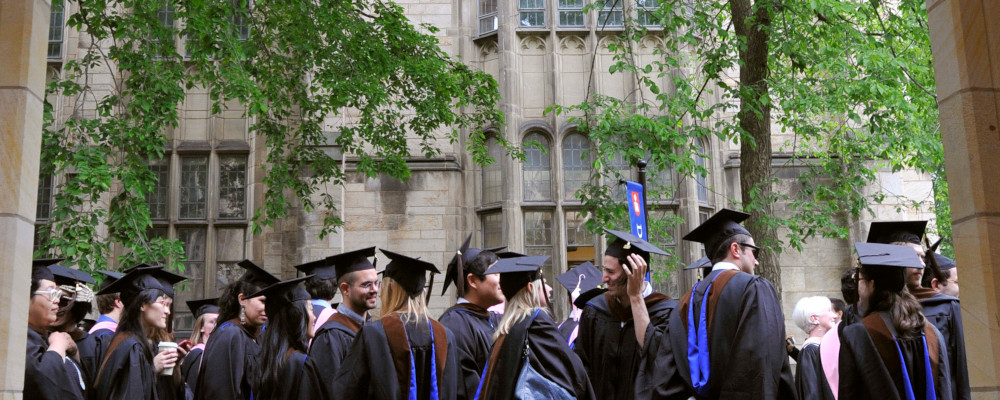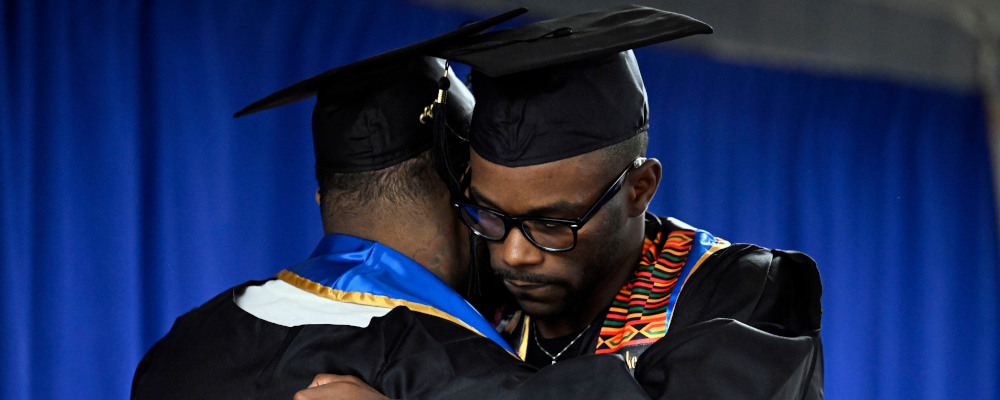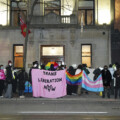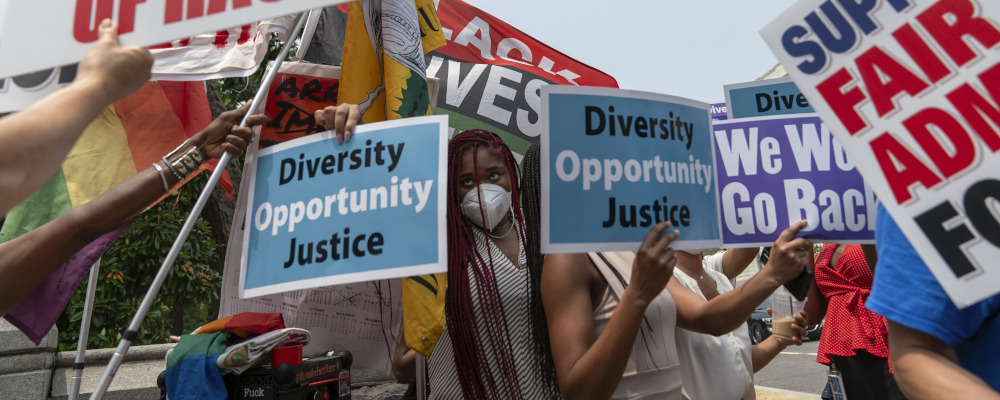Questions of race and class in relation to universities have been front and centre in the U.S. in recent weeks after a landmark decision on affirmative action.
At the end of June, the Supreme Court ruled that Harvard College and the University of North Carolina violate the Fourteenth Amendment and the Civil Rights Act of 1964 by using admissions procedures in which acceptance or rejection “can depend on race.”
It’s an epochal decision that likely marks the end of an affirmative-action era in American university life dating back to the tenuous BakkeThis was a landmark decision by the Supreme Court about whether preferential treatment for minorities could reduce educational opportunities for Whites without violating the Constitution. middle ground of 1978. And just this week the New York Times added fuel to the fire by headlining the results of an unprecedentedly large empirical study of the family income of students admitted to a representative subset of Ivy League and other elite institutions of higher learning. The study confirms in granular statistical detail what was obvious to any lower-class kid like me who attended such schools: the students there are almost entirely very well-off! It was already well known that roughly 85 percent come from families with upper-middle-class incomes or higher. The new data makes clear that a disproportionate number are also the progeny of the super-rich.
In response to the Supreme Court ruling Harvard has accordingly announced that it is reviewing its admissions procedures and the University of North Carolina put out a statement this week saying it will no longer consider race. Perhaps anticipating the larger public relations crisis brewing, Wesleyan University has stated that it is terminating preferences for children of alumni. More such statements will surely be forthcoming. In addition to their long-nascent constitutional problem, elite university administrators are now faced with explaining to already battered lower-class Whites how putatively meritocratic institutions with vast influence in American life may continue to trumpet “diversity” and “inclusiveness” as they admit almost all of their students from the topmost economic strata, while reserving a significant number of the small remainder of spots to kids from a selected set of preferred ethno-racial groups, most of whom are also at least middle-class.

They have some special explaining to do to “Asians” as well, whose numbers are evidently kept down by procedural contrivances and mystification. But those most definitively squeezed out entail almost the entire enormous American population of poor, working-class, and lower-middle-class White kids. Is the American public really supposed to believe any longer that these kids are just not smart enough or involved in enough extra-curricular activities? It’s true, the report shows, that most of them fail to take up squash or fencing.
As a literature professor rather than a jurist I have no professional light to shine on the constitutional questions in play, except to note that I found the majority opinions to be compellingly argued. (It has long been acknowledged even by supporters of affirmative action that it proceeds in blatant defiance of the clear language proscribing race-based preferences in Title VII of The Civil Rights Act of 1964.) But as a formerly-lower-class White-ethnic kid who attended Yale as an undergraduate in the 80s and Harvard as a PhD student in the 90s, and who has read, thought, and taught for years about class in American literature and society, I do have some personal experience and considered perspective that might be of interest to university administrators and the larger North American public.
My anecdotal mini narrative goes neither to the cool logic of constitutional jurisprudence nor to familiar partisan positioning, though it does, I think, suggest a policy change. I am mainly concerned with the more psychologically intimate levels of affect, childhood development, and fairness at stake in the American people’s ongoing efforts to build a general culture of intersubjective social recognition commensurate with the all-inclusive promise implicit in its founding principle of universal natural rights.
“All beginnings are hard.” It is a measure of the difficulty of my own adolescent beginnings that I derived great solace from this simple sentence when I came upon it at the start of In the Beginning, a beautiful novel by Chaim Potok about a scholarly orthodox Jewish boy’s deeply conflicted coming of age. My very Catholic Italian American and French-Canadian mother, a nurse, had somehow come upon this book, and rightly guessed that it might be helpful to her bright, religiously serious, but struggling son. Although nobody knew yet that my (Irish American) father had fatal lung cancer, at age twelve I could see and sense that he was getting seriously sick, and bouts of paralyzing anxiety were keeping me home from school. But after he died a year or so later, I began to prefer school, Saint Patrick’s, then Saint Anthony’s, because the small suburban house I lived in with my mother and four brothers felt so tacitly sorrowful, so charged with manic denial, and so out of control.
Although suffused with fierce familial love and loyalty, it also became a place of gnawing economic worry, routine alcohol and drug abuse, untreated mental illness, outbreaks of violence, and sexual assaults on two occasions by a diabolical alcoholic priest, Father Robert Huneke, who preyed on my mother’s vulnerability to gain access to her handsome, high-spirited, heartbroken boys. (We never spoke about it, not once, until almost forty years later.) My mother was indomitable and resilient in her way, but in those days I also began to see in her a variant of what Jonathan Kozol noticed in poor African American children adopting the stoicism necessitated by a thousand hurts: “the gradual attrition of accepted pain.”
Not unlike Richard Wright or James Baldwin, though the racial dimension of their pain multiplies it exponentially, I came to find refuge, distance, perspectives, and increasingly a sense of self-empowerment beyond anxiety in reading, writing, remembering, studying, analyzing, thinking—in short, in school. I worked unceasingly at my high school assignments while also helping my mother and brothers in every way I could. I got a part-time job at Sears to begin saving money for college tuition that I knew my mother wouldn’t be able to afford. I trained myself to function well on little sleep and frequent hangovers. I got A+s in everything. I crushed the SAT first try with no prep. I graduated second in my class. I won several academic prizes at the ceremony. I got accepted with ample funding at Yale, Harvard, Princeton, Swarthmore, and Williams.
I don’t know whether the admissions committees had taken account of my class background as part of a holistic approach to my file. My recommenders would likely have mentioned my father’s death and general family circumstances in their letters. But having deeply internalized both Irish and Italian lower-class codes prohibiting the discussion of family outside of the family, I instinctively resisted talking about such matters when prompted in admissions interviews, though some of my socio-economic otherness would have been apparent in my very thick Long Island accent and my probably obvious discomfort in the preppy clothes I thought I was supposed to wear. In any case those acceptances conveyed not only meaningful recognition of my academic performance in high school, but also a deeper acknowledgement of something that every subaltern and/or abused child doubts in their heart: that I was not dirt, that I had genuine talents, that I had something to offer, that I was worthy in the world.
My friends and family and neighbours, almost none of whom had ever met someone who went to one of these schools, thought my amazing acceptances meant that I was going to get rich. I was already pretty sure, however, that I wanted to become a teacher of some kind. I chose Yale mostly because it offered a special selective “Great Books” kind of program called “Directed Studies” in the first year on a competitive entry basis. Grief and substance abuse and recklessness and rage seemed finally at bay that summer as I worked my Sears job and counted the minutes until I could head across the Long Island Sound to New Haven. But, of course, human selves, embedded in their own and larger histories, do not transform so abruptly. When I found out in August that I wasn’t accepted into “Directed Studies” I was so disappointed that I went out drinking hard with my brothers and buddies and I could have died because I threw up in my sleep.
Missing out on “Directed Studies” notwithstanding, Yale proved nothing short of transformational for me on every level. Habermas uses the phrase “context shattering” to characterize the West’s difficult but emancipatory shift into modernity; the phrase also well captures my whole educational experience at Yale. To summarize four growth-packed years in a phrase, Yale didn’t just broaden my horizons, it blew them apart, while also giving me the critical and imaginative resources with which to reflectively sift the pieces and reassemble them into a new self, built upon but also disjoined from who I had been before. “I [became] larger, better than I thought,” as Whitman writes in Song of the Open Road, “I did not know I held such goodness.” Partly this experience of ongoing ecstatic discovery of self and larger world, past and present, was a function of fantastic course offerings and unfailingly excellent, inspired, rigorous teachers.
A wonderful friend (from a brilliant upper-middle-class-Jewish academic family) and I would excitedly pore over the Blue Book of course descriptions at the beginning of every term. Over four years I was able to put together my own ad-hoc extended version of the Directed Studies “Great Books” arc across Western literature, philosophy, and history from Homer to Ellison. But more to the present point, the self-transformation I experienced over those four years was also a function of a kind of student diversity that had little to do with the Black-White racial binary.
It was with a close Korean-American woman friend from a highly educated and artistically accomplished background that I mainly shared my love and increasing knowledge of lyric poetry, something I never would have done back home. She also introduced me to classical music, and when I smuggled an open can of beer into one of her violin recitals, she sharply, and rightly, challenged me about my drinking. I was struck and impressed by the fact that she, and others of my more academically focused new friends, candidly expressed skepticism about the value of drinking at all, and it moved me towards a far more moderate approach that I have retained ever since.
My new friends also did something else that amazed me: if they had a lot of studying to do or papers to write, they didn’t go out on weekend nights, and they were not in the least ashamed to admit it. (I had always had to mask my academic seriousness from high-school peers). Especially it is impossible to overstate the salutary impact of intellectually serious Jewish-American fellow students from more sophisticated backgrounds on a very provincial Catholic kid from a mostly Catholic little world. (The first time I flew in an airplane was in the summer of my second year at Yale, when I went to Chicago to work on repairing expensive boats with another new upper-middle-class friend.)
From first year to last, the aforementioned “blue book” friend also hammered at my provincialism by engaging me in unceasing and unsparing intellectual challenges in the dining halls, on the way to classes, in the libraries, in our dorms. We took many courses together and we intensively discussed and argued about the readings and lectures. He compelled me not only to explain and defend my evolving political and philosophical views such as they were, but also, as we got to know each other better, to generally talk more openly about my thoughts and feelings. Whereas I was the product of a lower-middle-class White-ethnic culture of limits and wary silences, he was the product of an upper-middle-class academic culture of expansive confidence, loving contention, and ceaseless verbal exploration. His eloquent friendship helped me to fully realize nothing less than my human capacity for sincere, communicative, cathartic speech.
I think friendship with me, paradoxically, also broadened the horizons of my more advantaged friends. Some of them later admitted that because of my Long Island accent they at first couldn’t understand what I was saying (when I spoke at all). But they liked me, as I liked them, and they were sincerely interested in the fact that I had grown up so differently than they had. While critical (fairly enough) of the repressive and persecutorial aspects of historical Catholicism, they were also respectful and curious about my attachment to it as a tradition of community, mercy, self-stabilizing ritual, visual beauty, and solidarity with workers and the poor—in possessions and/or in spirit.
Whereas I admired and increasingly sought to acquire their sense of self-agency and personal power in the world, many of them conveyed to me in one way or another that they admired the intensity of my family and neighbourhood bonds. One of my older brothers died of a cocaine-related cardiomyopathy three years after I graduated: a super wealthy Yale friend then living in New York City, whom I had not seen or spoken to since graduation, got himself onto the Long Island Railroad commuter line, figured out the switches at Jamaica and Huntington, called a cab at Smithtown, and arrived on time to Saint Patrick’s for the (devastating) funeral. I’m sure he had already travelled to a lot of interesting places, but it was a pretty safe bet he’d never thought to journey out into Long Island’s endless sprawl of subdivisions. I’ll always love him for making that trip.
I benefited immensely from numerous Jewish-American professors also, who brought to Yale, as to so many excellent American universities, a secularized version of their great tradition of reading and interpreting and discussing. Once in my third year, a gentle, vastly learned, yarmulke-wearing Talmudic professor of the Bible, Milton, and Romanticism stopped me in a library hall, reached up to put his hand on my shoulder—I was a good bit taller than he—and told me he was “proud of me” because I had written, (in part by staying in on weekends) an excellent term paper on Shelley. He had no way of knowing the special power of such a phrase for a kid who had lost his beloved father as an adolescent. With a true teacher’s instinct, he simply understood the psychological importance of this kind of recognition for a growing young person.
I would be lying if I said that it never bothered me that almost everyone I met at Yale, including most of the professors, obviously came from far wealthier families than I did. But in some ways, I learned as much from encountering these upper-class folks as I did from reading and discussing Shelley or Sartre. I was repeatedly struck, for example, by how many of my new friends also had siblings at Yale, or at other Ivy League schools. These were not for the most part legacy kids or children of large donors, though I got to know a few of these as well. (I roomed with George H.W. Bush’s nephew one year.)
These sets of brothers and sisters were rather for the most part children of very prosperous professional, academic, or corporate families, and their presence together suggested to me a class-cultural factor that wasn’t only about material resources. For them, getting into Yale or other Ivy League schools was not the culmination of a long, solitary, and implausible struggle as it had been for me. It was rather more often the fruition of upper-middle-class family cultures in which very high levels of academic achievement and elite university attendance were expected and greatly facilitated by parental savoir-faire regarding how to help make this happen for their children, in part by procuring the best available schooling, but also by certain kinds of highly attentive nurturing.

I often thought that whereas I had been raised largely by my older brothers and friends, these folks had been raised, happily for them, by their parents! It would have been easy merely to resent and denigrate all this as the form that the cultural reproduction of American class privilege takes. There is certainly some truth to this view, and I sometimes inclined towards it. But as I came to know very well a good many people, including several sets of siblings, from this sort of background, I also came to see the extent to which the American upper middle class, for all its exclusiveness and large command of resources, is not akin to an exploitative European aristocracy or haute bourgeoisie.
Somewhere in the not-very-distant past of most of these families, often just one or two generations back, there was usually someone, often an immigrant or a child thereof, who, like me, had good intelligence, realized that school was a way out, got serious, worked hard, and broke the class mold. They then often sought to establish a family culture for their children that was maximally conducive to further such flourishing, both intellectual and material. The more I got to know such people, the less I was inclined to sweeping class-based disparagements, even as I came to see more clearly how a certain kind of upper-middle-class ethos provided advantages I never had. This was one of the bases of entrenched inequality, yes, but it was also a new model to borrow from when it came to founding a family culture of my own.
It was in part by adopting what I had come to think of as upper-middle-class values of disciplined long-term planning that I took all the steps necessary to get into Harvard’s PhD program in English in 1989. I had known upon enrolling that the job market for humanities academics was very tough, and I was prepared to go anywhere in the country and work at any kind of post-secondary institution once I was finished. (I sincerely felt, as I still do, that I could happily teach any kind of kid.) I again put in very long hours at my studies, and I produced what many demanding assessors told me was truly exceptional work. I won two teaching prizes; I got an article (on Shakespeare’s sonnets) published in a very prestigious journal (Raritan); and I won the (university-wide) Bowdoin prize for best humanities dissertation in 1999. I also gathered a dossier of recommendations from some of the most highly regarded figures in their fields, one of whom, famously not given to easy praise, had commented on one of my papers that I had “a true gift for criticism.”
They all (male and female) repeatedly expressed shock and dismay when I got no job offers over three years despite sending out almost a hundred applications. Only in the fourth year, as I was preparing to go to law school, did I get the job I currently hold at the University of Toronto, for which I was and remain grateful. But I loved my country—its variegated people of every stripe or status, and its remarkable difficult arc, however long it was taking, towards justice. I had long hoped to spend my life reflectively engaging in a dialogical process of “making Americans” as Gertrude Stein puts it, including continuing to make myself, in conversation with other Americans.
Most of my advisors, fellow graduate students, and friends said versions of the same thing by way of explaining my growing pile of rejection letters (and racial self-identification cards): “You’re a White male who wrote your dissertation about a White male”—about Emerson and classical liberalism, subsequently published as a book by University of Wisconsin Press in 2009. Though I was reluctant to believe this at first, virtually everyone else in the profession who I have talked to since has acknowledged its truth, with varying degrees of discomfort.
It was and remains a bitter pill to swallow, though I am temperamentally incapable of sustained bitterness. After having overcome extreme childhood adversity, after years and years of extraordinary effort and dedication, after having definitively demonstrated highest-level talent as a teacher and scholar, it seemed that my country had judged me by the colour of my skin, not by my ability, hard work, persevering character, and commitment to a socially valuable vocation.
I was merely “White.”
Although I didn’t and don’t expect any special treatment, it is also pertinent to the question at hand that the possibility that I may have been socioeconomically disadvantaged in background didn’t even register, while imputed or historical racial and gender disadvantage did play a part in other candidates’ preferment. In the eyes of the hiring committees, it seemed, I was not an Irish/Italian/French Canadian American, I was merely “White.” I was not a formerly lower-class kid, I was merely “White.” More scandalously, I was not the young author of an original prize-winning study of an important thinker and writer who had woven into a comprehensive and inspiring symbolic system the world-emancipating idea that an individual’s fate ought not to be determined by the circumstances of their birth: I was merely “White.”
Thus classified, I was merely the flip side of a specious, reductive, and incalculably destructive binary. I couldn’t help but feel that the hiring committees had performed on me a repetition in reverse of the erasure of difference and particularity done to millions of Africans when they were carried by force out of their variegated cultural contexts and informed that they were “Black.” Of course, the committees could say that there was no way to tell from my file that I had been disadvantaged. But there’s no way to know that for certain about a Black or Hispanic or female applicant either just by their gender or the colour of their skin.
The categories of measurement must be more fine-grained if matters of disadvantage are to be considered at all. Most of the minorities and women I knew in graduate school came from backgrounds substantially more economically privileged than mine. The question of compensation for historical wrongs is at best a vexed one in legal thought because it raises the problems of both victim and perpetrator specificity. But I don’t think even its most ardent advocates contemplate that the burden should fall especially heavily on lower-class people. Because upper-class folks almost by definition have more life chances, however, this is in effect what happens to lower-class White folks in the context of affirmative action in selective university admissions or in competition for employment.
However I have tried to rationalize it, I can’t get around a sickening certainty that both as a graduate student and since I have been discriminated against on the basis of race and gender. I have also witnessed this happen more than once to other job applicants at the University of Toronto, where my speaking up to object has met with subtle and not-so-subtle forms of administrative disapproval and constraint. Indeed, the practice of a kind of reverse racism has become so commonplace and ingrained in contemporary North American academic culture that it is taken for granted and cannot be freely questioned.
How ironic that affirmative action at universities was famously moved forward by Justice Powell in the Bakke case on the grounds that it would contribute to diversity of points of view in classroom discussions! Reports from universities around North America in recent years indicate that I am far from alone in perceiving that EDI initiatives are having the reverse effect. And in terms of political points of view, English departments are now well known to be almost entirely homogenous.
I don’t know whether my American experience technically raises any constitutional problems in light of the recent Supreme Court ruling. But as I said at the start of this essay, narrow legal disputation is not my main concern here. I have rather sought to use my personal narrative to illustrate the continuing broad cultural pertinence of the most longstanding critique of affirmative action: its refusal of recognition to the legitimate but precarious aspirations of lower-class Whites.
Some on the farther Left have met the Supreme Court ruling with outrage and the now commonplace but nonetheless shockingly presumptuous imputations of unconscious racism. Have they not heard about Anne Hutchinson or Roger Williams? Have they not read their Locke or Hawthorne? Do they not know that near the heart of modern Anglo-liberalism and all our North American freedom lies a principled defiance of the presumption of moralizing authorities to know what lies in the heart of another human being? How should we begin or end, for that matter, to extirpate unconscious class bias, including among upper-class minorities, except by the methods of Mao, or the Khmer Rouge, or Xie?
This exiled American Democrat believes in any case that Students for Fair Admissions V. President and Fellows of Harvard Collegehttps://www.supremecourt.gov/opinions/22pdf/20-1199_hgdj.pdf is best taken as an opportunity for a new, more genuinely liberal beginning. Over the years, many defenders of affirmative action have creditably urged its continuance on the purely pragmatic basis that it appears to have worked to some degree. Although there is dispute about the causes, between 1967 and 1994 the black middle class quadrupled. Given the unique and horrific sort of systemic domination and demonization that African Americans faced for the first three centuries of their history in the New World, and given what we know about how slowly real change is achieved by historically embedded selves and societies, this is indeed significant progress that any fair-minded person, or anyone committed to America’s emancipatory founding principles, should be loath to impede. And yet at the same time this progress has come at significant cost in basic fairness to lower-class Whites, such as I have sketched in my own case.

In its largest political-cultural ramifications, furthermore, this deeply and legitimately resented unfairness has also contributed to the sundering of the once potent New Deal-Kennedy-Johnson coalition between African Americans and lower-class Whites, especially northern White ethnics. And this weakening of the Democratic party in turn has slowed progress on many other important fronts —such as universal health insurance, more effective anti-poverty programs, more progressive education funding, sensible gun laws, a science-based response to global warming, and, most recently, the defeat of Donald Trump. So rather than doubling down on current affirmative action practices by seeking merely to evade the new ruling by minor tweaks, I would urge university administrators and lawmakers and Americans in general to advocate and explore variants of class-based affirmative action such as have already been initiated in Texas and California.
In an important 1996 book by Richard D. Kahlenberg entitled The Remedy, now aptly getting fresh attention, the author powerfully makes the case for this idea. By urging a focus on the commonalities of class disadvantage, he channels the moral force of Martin Luther King’s and Robert Kennedy’s inspirational efforts to bridge the gap between African Americans and working-class Whites. And he also delves into the hard numbers, policy mechanics, and partisan political challenges.
In sum, he argues that by a shift from race to basic family economic profiles (easily garnered from tax returns) as the basis for “soft” preferences in university admissions and government contracts etc., administrators and policymakers could cease their unsavory and unfair dealing in the racially essentializing categories that the fourteenth amendment and the Civil Rights Act of 1964 explicitly and appropriately forbid. But this would also allow them to continue to reach out affirmatively to the many lower-class African Americans still suffering from the economic legacy of racism, as well as to lower-class Whites. This would not only be patently more just from a moral-philosophical viewpoint, but from a pragmatic political point of view it could also help to heal, to strengthen, and to revitalize the Democratic party.
From a purely educational point of view, as I have tried to anecdotally sketch above, class diversity is no less valuable than racial diversity in creating a rich university experience in multiple dimensions of the developing personality. Ideally, a genuine diversity of races and classes should interact on campuses in a dynamic, dialogical, multi-dimensional, and candid counter to the dominated ways in which Blacks and lower-class Whites have historically inter-related in American society. The larger American culture, within academia and without, can only benefit from thus seeking to begin again and go beyond the baneful racial binary that has blinded so many for so long.
Recommended for You

The Notebook by Theo Argitis: Carney’s One Big Beautiful Tax Cut, and fresh budget lessons from the U.K.

Ginny Roth: How vacant liberal nationalism left Canada worse off than George Grant even imagined

Matthew Grills: Joey Chestnut is America

Peter Menzies: Justin Trudeau’s legislative legacy is still haunting the Liberals



